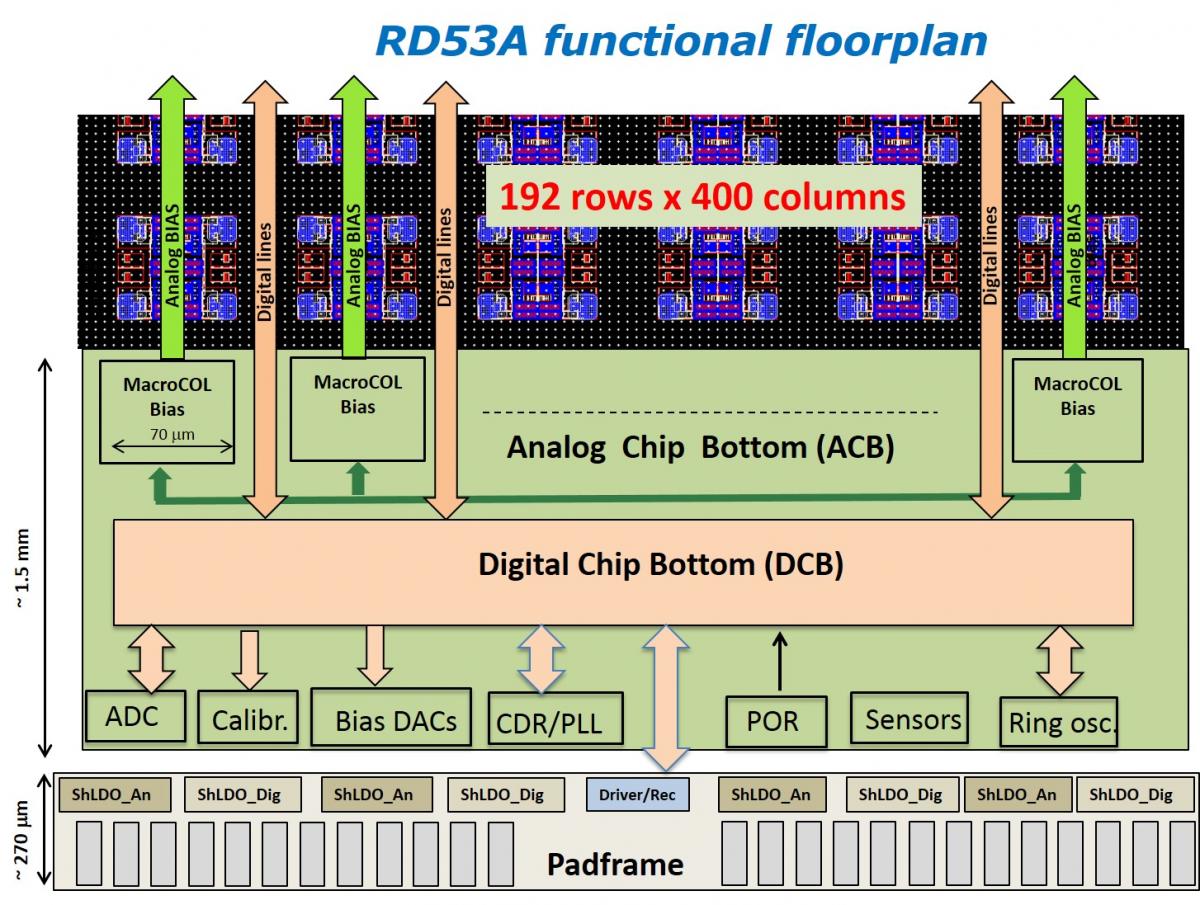RD53: a large scale demonstrator pixel chip for the phase 2 upgrades of ATLAS and CMS
The RD53 collaboration presented the RD53A large scale pixel chip demonstrator in 65nm CMOS technology as a vital milestone to make viable pixel detectors for the ATLAS and CMS phase 2 upgrades. The RD53 collaboration has during the last 4 years worked on a focussed R&D effort to develop circuits and architectures for phase 2 upgrade pixel chips to handle the extremely high hit rates (up to 3GHz/cm2) and extremely high radiation levels (1Grad over 10 years). Being only a few centimetres from the proton collisions at the centre of the CMS and ATLAS experiments impose many severe challenges in combination with the need of small pixels of 50x50um2 (or 25x100um2 using same chip) for effective tracking in the high track density events characteristic of the HL-LHC, with up to 200 primary interactions per bunch crossing. The increased hit rates at HL-LHC, combined with a factor ~10 increase of trigger rates of the upgraded experiments, implies a factor ~100 higher readout rates compared to current pixel detectors.

Fig. 1. Layout of RD53A demonstrator pixel chip. The inclusion of 3 different analogue front-ends are visible as slight colour differences between the 3 parts of the pixel array. The chip has for cost reasons been made half height of final pixel chips to allow expensive masks and prototyping costs to be shared with the MPA and SSA chips, vital chips for the phase 2 CMS outer tracker.
The RD53A demonstrator chip will be used for extensive verifications of required hit detection efficiency, charge resolution, low noise, high hit and trigger rates together with needed radiation tolerance. Hybrid pixel detector assemblies, made from this pixel chip with bump bonded pixel sensors, will be extensively tested to confirm if the developed circuits and architectures are a solid foundation to make final pixel chips for the phase 2 upgrades of the two experiments. The use of a serial powering scheme, with dedicated on-chip Shunt-LDO power regulators, will also be extensively verified with the RD53A chip as this is a vital part of making a pixel detector with an appropriate low mass power distribution system.
This chip submission is the result of a 4 year R&D effort to make radiation tolerant and high rate circuits by the 19 institutes participating in RD53. Many different circuits ( analogue front-ends, DACs, ADCs, bandgaps, analogue buffers, PLLs, drivers/receivers, power-on reset, serial power regulator and dedicated radiation test structures ) have been prototyped and extensively tested as individual elements and also as part of small pixel array prototypes. The integration of the different building blocks into the large scale demonstrator pixel chip and the verification of overall functionality has taken place during the last year by a core design team (~10 designers) that have spent the last four hectic months together at CERN to assure efficient daily communication, critical for the design of such a large, complicated and delicate mixed signal integrated circuit. Radiation effects at these extreme radiation levels have had several surprises for us that is now much better understood such that a combination of special and conservative design approaches and the fact that these chips will be operating cold at -20 - -30 oC should enable these chips to maintain their full performance over their required life time of 10 years (possibly only 5 years for inner layer that is only ~5% of pixel detector area).

Fig. 2. Functional overview of RD53A pixel chip
While this new demonstrator chip will be extensively tested and verified during the coming year, by the pixel detector communities in both ATLAS and CMS, the chip designers will start to design the final pixel chips for the two experiments with some experiment specific features ( pixel chip size, trigger scheme, readout, etc.). The development of such a complicated, challenging and expensive chip among 19 institutes with the chip designers scattered across Europe and the US, from both ATLAS and CMS experiment communities, has been a significant challenge that has required an appropriate project organization and, most important of all, a highly motivated and strongly dedicated design team to work together across country and experiment frontiers.
RD53 members: Bari, Bergamo/Pavia, Bonn, CERN, CPPM-Marseilles, Fermilab, Milano, New Mexico, NIKHEF, LBNL-Berkley, LPNHE-Paris, Padova, Perugia, Pisa, Prague, RAL, Santa Cruz, Seville, Torino (plus specific contributions from Dortmund, Glasgow and LAL-Orsay)
